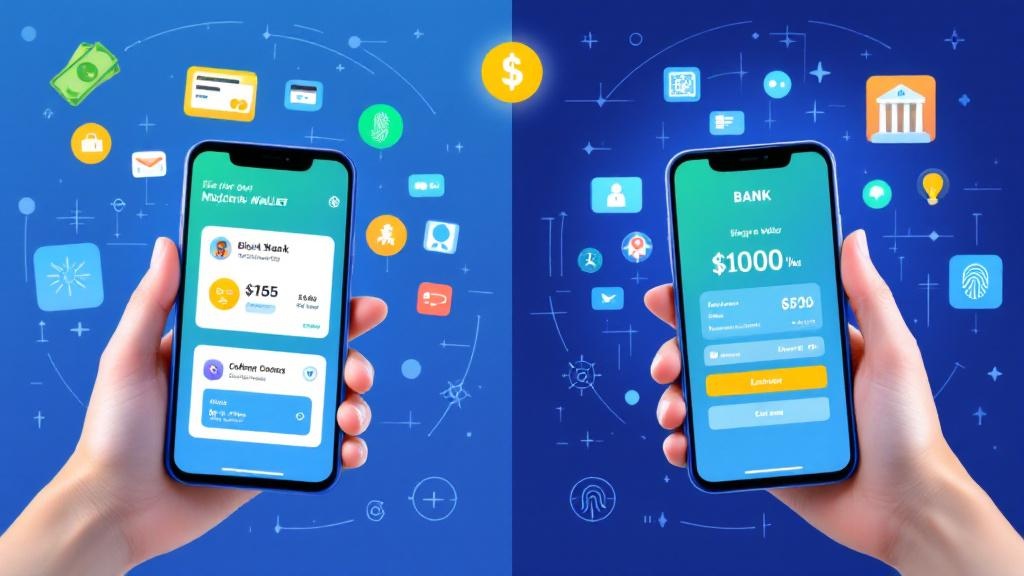In today’s fast-moving world, how we handle money is changing fast. Paper cash is slowly being replaced by smartphones, QR codes, and tap-to-pay features. But when it comes to managing your finances, you’re likely torn between two powerful tools: digital wallets vs bank apps.
So, which one is right for you?
Let’s break it down in simple terms and help you decide whether a digital wallet or a banking app better suits your lifestyle, preferences, and spending habits.
🔍 What Is a Digital Wallet?
A digital wallet (also called an e-wallet) is an app that stores your payment information digitally. It lets you pay online or in stores without needing physical cards or cash. You can also store loyalty cards, metro passes, and even event tickets.
Popular Examples:
Google Pay
Apple Pay
PhonePe
Paytm
Samsung Wallet
These apps are often connected to your debit/credit cards or bank accounts and are designed primarily for contactless transactions, peer-to-peer payments, and mobile commerce.
🏦 What Is a Bank App?
A bank app is the mobile version of your bank’s online platform. It gives you direct access to your bank account, allowing you to view balances, transfer funds, pay bills, apply for loans, and more.
Examples of Bank Apps:
HDFC Bank MobileBanking App
SBI YONO
ICICI iMobile
Chase Mobile (U.S.)
Wells Fargo Mobile
These apps focus more on managing your overall financial health rather than just making payments.
💡 Digital Wallet vs Bank App: Key Differences
Let’s compare these two across various aspects so you can clearly understand the difference between digital wallet and banking app.
| Feature | Digital Wallet | Bank App |
|---|---|---|
| Primary Function | Quick payments, P2P transfers | Full banking services |
| Funding Source | Linked cards or UPI | Directly tied to your bank account |
| Speed | Instant payments | May take slightly longer |
| Functionality | Limited to payments & offers | Broad features like FD, loan, bill payments |
| Security Layers | PIN, fingerprint, tokenization | Multi-layered bank-grade encryption |
| Offline Use | Mostly online | Some offline SMS banking options |
| User Interface | Clean, fast, intuitive | More complex due to multiple features |
⚖️ Digital Wallet Comparison: Pros and Cons
✅ Advantages of Digital Wallets Over Bank Apps
Faster transactions: Great for instant payments, especially in stores or for splitting bills.
Rewards & Cashback: Wallets often give offers, discounts, or cashback on purchases.
User-Friendly Design: Simple interfaces tailored for quick use.
Contactless Support: Perfect for tap-to-pay or QR code scanning.
❌ Limitations of E-Wallets
Not full-service: You can’t check account balances, open FDs, or apply for loans.
Limited offline access: No SMS or phone banking features.
Reliant on Internet/UPI servers: Downtime can disrupt access.
🛠️ Bank App Features vs Wallet Features
While digital wallets are built for spending, bank apps are built for managing.
✅ What Bank Apps Do Better
Access to full bank services like savings, fixed deposits, loans, investments, and insurance.
Detailed transaction history with monthly statements.
Account management tools, including balance tracking and notifications.
Bank-led digital solutions like overdraft management and credit score tracking.
❌ Where Bank Apps Lag
Less intuitive UI.
Fewer promotional offers.
Might be slower for frequent, small-value transactions.
🔐 Security of Digital Wallets vs Bank Apps
When it comes to your money, security is non-negotiable.
📱 Mobile Transaction Security in Wallets
Use of tokenization: Card numbers aren’t stored on the device or shared during transactions.
Device-based security: Requires face ID, fingerprint, or PIN.
Real-time payment apps send immediate alerts on every transaction.
🏦 Bank App Security
Two-factor authentication for login and transactions.
Encrypted data storage and transfer.
OTP and biometric verification layers.
Regular fraud monitoring systems.
Verdict: Both are secure, but bank apps are backed by regulatory compliance and financial standards, giving them a slight edge.
💬 Real-Life Example: Riya’s Dilemma
Riya, a freelance designer in Bangalore, uses PhonePe for everyday payments—auto rides, grocery shopping, and food delivery. But when she wants to check her savings account, invest in a fixed deposit, or apply for a credit card, she uses her ICICI Bank app.
Her takeaway?
“Digital wallets are great for speed and rewards, but bank apps give me complete control.”
📲 Wallet App vs Banking App: When to Use Each
Use a Digital Wallet if:
You make frequent small payments (groceries, cabs, food delivery).
You love cashback and promotional offers.
You need a fast, minimal interface for peer-to-peer transfers.
Use a Bank App if:
You want full control over your financial portfolio.
You need to track your savings, loans, and investments.
You prefer managing all things money in one place.
🤝 Can You Use Both Together?
Absolutely. In fact, combining both can be your smartest move.
Link your bank account to a digital wallet.
Use the wallet for daily payments.
Use the bank app for savings, planning, and tracking.
This hybrid method gives you convenience + control.
📊 Digital Wallet vs Mobile Banking: Final Verdict
Still wondering who wins in the digital wallet vs mobile banking debate?
Here’s the answer: They serve different needs.
Use both smartly to build a seamless, secure, and efficient personal finance system.
❓ FAQs: Digital Wallets vs Bank Apps
1. What is the main difference between a digital wallet and a banking app?
A digital wallet is designed mainly for quick payments and peer-to-peer transactions, while a banking app provides access to full-fledged banking services like account management, loan applications, and investment options.
2. Is it safe to link my bank account to a digital wallet?
Yes. Digital wallets use encrypted technology and don’t store your actual bank or card information. For added safety, enable biometric authentication and check transaction notifications.
3. Which is better for contactless transactions: wallet or bank app?
Digital wallets are better for contactless transactions due to features like tap-to-pay, QR scanning, and faster checkout options.
4. Can I use digital wallets for international transactions?
Some wallets support international payments, but most are region-specific. For global use, apps like PayPal or multi-currency cards linked to your bank are better options.
5. Are digital wallets replacing traditional bank apps?
No. They’re complementing each other. Digital wallets enhance daily spending convenience, while bank apps remain the foundation for managing your finances.
6. Which is more secure: bank-led digital solutions or fintech wallets?
Both are secure when used responsibly. However, bank-led digital solutions typically have stricter compliance protocols and centralized security systems.
7. Can digital wallets help me with financial planning?
Only to a limited extent. While some wallets show spending categories, bank apps offer richer financial planning tools like savings goals, investment options, and account tracking.
📝 Conclusion: Which Should You Choose?
When comparing digital wallet vs bank app, it’s not about picking one over the other. Instead, it’s about knowing when and how to use each.
For fast payments, cashback, and convenience — go for digital wallets.
For managing money, savings, and overall finance — rely on your bank’s mobile app.
Use them together for a smarter, safer, and more flexible financial experience in today’s digital finance platforms era.








Comments (0)